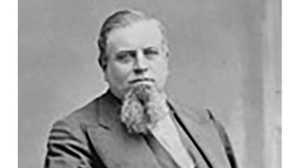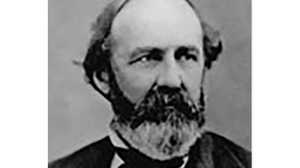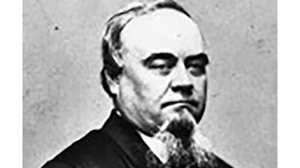Interview: Native Americans
From the Collection: Native Americans
In this interview, Donald Fixico, Thomas Bowlus Distinguished Professor of American Indian History and Director of the Center for Indigenous Nations Studies at the University of Kansas, talks about the West before white settlement, the impact of the railroad on Native American life, and the near-extinction of the American buffalo.
What was the West like before white settlers came?
The world of Plains Indians and of other American Indians in the West had existed for several centuries. The eighteenth century, in particular, represents the West as we think about it before the arrival of the white man. This enormous area of the Great Plains, Southwest, Pacific Northwest, and Basin area represented the homelands of many Indian communities. At least 28 tribes might be called Plains Indians. Trade alliances existed among these peoples, and protecting hunting domains was important to their economy, depending on the natural resources of the environment, which included antelope and smaller game. North American Indians shared their world with two types of buffalo (plains and wood), eight species of bear, three primary species of wolves, 59 species of eagle, 150 species of antelope and 38 species of deer.
The natural environment helped to shape the people's thinking and cultures as they viewed the world and the Universe in a native perspective of a physical and metaphysical reality. For example, in Kansas, at night, if you look at the stars you will realize how vast the sky is and during the day you see how enormous clouds roll across the blue sky, often bringing an approaching rainstorm. All of this affected how Plains Indians looked at things as they thought about how powerful the natural elements were around them. In the West, there's so much land, so much space, air, clouds, and everything. It's almost magnified by the Rocky Mountains to the west. They're awesome. Rivers when they're flooding are dangerously powerful. A tornado, too! So, these things are much greater than a human being and Plains Indian people felt this — the enormous power of Nature!
What kept Native Americans so faithful to the land?
The natural environment of the Great West provided life to American Indians. It also took life! People learned that working together, and hunting together, was extremely important! Living alone on the plains meant certain death. It was a hard life, taught by Nature. The power of a tornado, a thunderstorm and its lightning, the pressing heat of a summer day, or the sweeping cold air made everyone to be acutely observant of the Earth. The native people learned from the Earth and the animals and plants. Everything fit together in this Universe as the Plains Indians understood it, and everyone and everything had its role and responsibility.
How did white settlers affect that world?
The world of the American Indian changed with the coming of the white man! In some of the prophecies and stories, it is thought that it was meant to be. The white strangers were different, very different, but both races would learn from each other.
Anglo-American settlers of England, Spain, France, Russia, Sweden and the Netherlands began to change native America during the early 1500s. Spanish explorers looking for bullion (gold and silver) began to impose European values upon American Indians. Closely following these monetary explorations, Christianity was introduced and missionaries often accompanied the European explorers during the mid-1500s and late-1500s. European usage of metal tools altered Indian ways of life, especially as the gun, or rifle, and the plow, meant the European colonies were deliberately planned to settle the so-called New World. The European presence introduced at least a dozen strange diseases during this era that American Indians had no natural immunity against. The native population suffered enormous losses. It has been said that more native people died due to foreign diseases than were lost in wars fighting for their homelands.
The "white intruders" brought much change to Indian people. Who is to say that it was not meant to be that way? Yes, all of the North American continent has been taken away, except for about two percent that American Indians still have that they call their homelands. The American Indian almost disappeared with the buffalo when less than a thousand buffalo were left by the turn of the 20th century, and only 225,000 Indians had survived the deadly new diseases and more than one thousand wars. But life was hard; it was never meant to be easy — not for anyone! Perhaps, that is what all of us must learn for the 21st century. That we should not waste our natural resources and that we should value the natural environment, or else we will destroy ourselves.
Was it inevitable that European Americans would seize Native Americans' land?
The U.S. Government began to make treaties with the Plains Indians during the 1850s to 1871 when a Congressional act halted the process of treaty-making with Indian nations. An important precedent had already been established with the removal of the majority of eastern woodland tribes via U.S.-Indian treaties during the 1820s to 1840s. Treaties remained as the legal means for obtaining Indian homelands as the ultimate goal, although such agreements first identified plains groups with certain lands with the second phase creating Indian reservations throughout the West.
In all, there are 389 ratified U.S.-Indian treaties, and majority of these have been broken by the U.S. The desire for Indian lands by white settlers created an uncontrolled momentum that would break any promise by the American nation. Yes, some provisions were carried by the U.S., and treaties were violated. New treaties had to be made to make up for the earlier broken ones, but then these could not be kept as the pressure of Manifest Destiny in the railroads, quest for gold, silver, and ranchers and settlers wanting land to build homes created an incredible force of desire! The idea of "owning" land was foreign to the American Indian who could not conceive of owning the Earth until the land was taken away. The Indian believed that he was a steward of the Earth, but the white man had a different understanding of land.
Did treaties affect the route for the transcontinental railroad?
Treaties made with the Five Civilized Tribes following the American Civil War and subsequent treaties made with Western tribes made huge amounts of surplus land available to public domain, and especially to rights of way for railroad construction. Although such treaties did not include railroad construction in their treaties in the West, the opening of more land to white interests certainly involved the routes of the transcontinental railroads.
Did different tribes relate to the government in different ways?
Today there are 562 federally recognized American Indian tribes. Historically, they have all related to the U.S. government in various ways, although there are patterns and trends in these relationships. Specifically, tribes applied various strategies in dealing with the U.S. Some tribes fought on the battlefield as in the case of many of the plains tribes and tribes of the Great Lakes regions and in the Southeast and in the Southwest. A few groups like the Eastern Cherokees challenged the U.S. government in its own courts. Other tribes like the Sac and Fox applied delay tactics while being forced to remove from their homeland of the western Illinois area to Iowa, then to Kansas, then to Oklahoma. It is important to keep in perspective that in the early U.S.-Indian relations that the Indian nations were more powerful than the young United States.
Why is the buffalo important to Native Americans?
The buffalo is a great symbol and great being to the Plains people because it's really their staff of life and even more than that. The Plains Indians had developed their cultures, communities and way of life around the buffalo. At the utmost, the 24 to 28 Plains tribes had figured out how to use the buffalo in 52 different ways for food, supplies, war and hunting implements, things like that. And so, the hooves, for example, are boiled to use as glue. The hump back is, that part of the buffalo is really kind of sturdy, and so it's used for making shields, the hides for making a teepee, for example. It took about 12 to 14 hides to do that. The buffalo was indeed plentiful and was the most important natural resource to the Plains Indians.
How did white settlers view the buffalo?
It became obvious that Indians and whites viewed the buffalo from differing points of view. Plains Indians had learned to hunt the buffalo skillfully with a bow and arrow, while the white professional hunter hired to supply meat to railroad crews used a rifle of long distance accuracy. While the Indians became dependent upon the buffalo, Anglo-American culture stressed the cultivation of the land as agrarians with less importance placed on the numerous buffalo. As a result, the buffalo was hunted for sport by the white professional hunters and sportsmen. In contrast, the American Indian of the West had developed a cultural importance on the buffalo as the center of ceremonial and daily life.
What is the difference between a buffalo and a bison?
Most people think that there is no difference between a buffalo and bison, but actually there is one. A "buffalo" can also refer to a water buffalo, and it is a term that describes a larger category of wild oxen. Bison more appropriately describes the North American buffalo, which has short horns, a heavy forequarter, a large head with a heavy mane. When Europeans first saw the bison, it is logical that they called it a buffalo that was similar to what they knew about in other parts of the world.
Is it true that the buffalo nearly became extinct?
It has been estimated that the West held as many as fifteen million to sixty million buffalo at the arrival of the white man. Even with the lowest estimate, the number was severely depleted as a result of the introduction of the transcontinental railroad to the Western homeland of the Plains Indian tribes. By the end of the 1870s, the buffalo was on its way to extinction with an alarmingly low number of less than 1,000 in the West by the end of the nineteenth century. Rapid American expansion in the West in less than fifty years caused catastrophic results for the great animal called the American bison. We're talking about an animal that was almost literally erased from this earth.
What factors contributed to the buffalo's disappearance?
One might imagine that waves of technology involving the railroad, economics of a ranching frontier for cattle and mining frontier for gold and silver, ecological disturbance of agrarianism changing the habits of the buffalo, and demographic change of white settlements, towns, then cities in the West represented the major causes for the destruction of the buffalo. All of these factors did not occur at once, but in an overlapping pattern and movement called Manifest Destiny, American expansion in the West had changed the balance of nature permanently.
Did the transcontinental railroad impact buffalo herds?
One might call this a "permanent corridor" that resulted in the demise of the bison in the West. Permanent railroad tracks, depletion of trees for railroad ties and bridges, and decreasing the wild game established an everlasting foreign presence in the indigenous West that would be changed to the American West with a new character called the "frontier." Something had changed forever! The white man may think that he owns the land, but he does not own the Earth. We are reminded of this important lesson, even the earliest white pioneers learned this important lesson trying to carve out homes made of sod on the plains. On the plains, we learn to look up when thunderclouds form and turn black. We are reminded of the power of Nature when it thunders and bright streaks of lightning shoot across the sky. We fear tornadoes, or else we are fools.
How did the Plains Indians react to the loss of buffalo?
For the Plains Indians tribes, it affected their whole scheme of life, and understanding of their Universe. And they saw that their life was being taken away from them. Plains Indians began to realize that they were going to have to do something and to fight for their lands, in a way to fight for the buffalo. They're defending their lands. I mean anyone would defend their lands, their homelands.
What is the buffalo's status in America today?
It is unlikely that the American buffalo will regain its once great herds. It has become evident that the population of the bison has increased with buffalo becoming a small part of the meat industry for public consumption. In addition, several Plains tribes have invested into starting herds of buffalo in an effort to bring the buffalo back to importance as a part of the Plains economy and for tourism. Most of all, the American buffalo is an everlasting symbol in the United States and to the world that reflected the Golden Age of the Plains Indians in the nineteenth century.
Could the railroad and the world of the Plains Indians have co-existed?
It would seem unlikely that the railroad and the Plains Indians and buffalo could live together in one rapidly changing world. The problem emerged with the railroad bringing an increasing number of white settlers and opportunists to the West, once the homeland for both the Plains Indian and the buffalo. Incongruent sets of cultural values and polarized mindsets found the Plains Indians and white settlers at odds. Such differences between Indians and Europeans would not allow them to live together until one defeated the other. More than a thousand wars were fought — Indian versus white. One way of life against another one, but the victor does not always win. Hopefully, he learns. Hopefully, he learns that he must learn to live with and co-exist in other human beings for all living things are not the same.
The railroad brought so much change at a rapid, exhilarating rate. It meant change in the lives of Indian people, white settlers, even the game in the area. In a way, it was the mark of an era, an era that meant perhaps even national completeness. It was a change beyond the control of the Indian, beyond his comprehension. And, such change was beyond the control of the white man, too! Perhaps, it takes a long time for two such different people to live side by side. When you think about it, a hundred years is not very long — and that was the 20th century. Perhaps, in the 21st century, we are supposed to live and work together.







